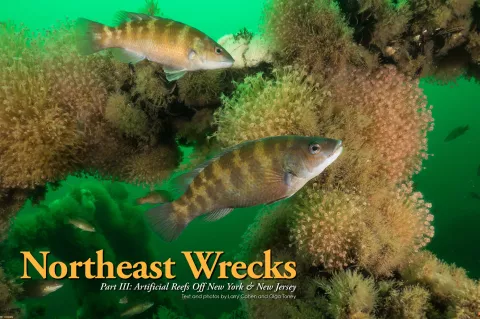In Part One and Part Two of this series, we discussed US Northeast wrecks that sank because of collisions and war. There are also many structures that have purposely been sunk as artificial reefs off the New York and New Jersey coasts. Larry Cohen and Olga Torrey have the story.
Contributed by
The National Oceanic and Atmospheric Administration (NOAA) defines an artificial reef as any man-made structure that may mimic some of the characteristics of a natural reef. Everything from tires, concrete reef balls, tanks, subway cars and barges to ships has been sunk as artificial reefs to attract marine life to a barren area. They have been cleaned, so they would not cause any environmental damage. In this article, we are going to talk about two ships that are now artificial reefs.

Venturo Tug
George S. Lawley and Sons of Neponset, Massachusetts, built what is now called the Venturo Tug for the United States Army in 1943. This 86ft-long, 146-gross-ton tug was named the DPC-14. The vessel was used as an ST-class tugboat. In the late 1940s, the boat was transferred to the Wartime Shipping Authority and renamed the WSA-1. Finally, it was sold to the Turecamo Coastal and Harbor Towing Corporation. Its name was changed to Matt Turecamo. All the tugs owned by Turecamo Coastal and Harbor Towing Corporation had a wood-grain paint job.

The tug was sunk inshore close to Point Pleasant, New Jersey, on the Sea Girt Artificial Reef in 1996. The boat sits upright in 80ft of water, but you can reach the main deck at 65ft. This dive site was renamed the GA Venturo Tug in honor of Captain Greg A. Venturo, who lost his life while scuba diving.
The Venturo Tug is an excellent dive for both new and experienced divers. It is a short boat ride from the Point Pleasant area marinas, and visibility is usually superb. The boat is intact, but the pilothouse was blown into the sand a few years ago. The propeller can still be observed under the stern. The wreck’s interior is easy to explore since large cutouts on both sides were made before the ship was sunk. The Venturo Tug is covered with marine growth and is now home to an assortment of marine life.
USS Algol AKA-54
The Moore Dry Dock Co. in Oakland, CA, built the USS Algol AKA-54 in 1943. This 459ft by 63ft Navy transport ship, which displaces 13,910 tons, is the largest vessel in the New Jersey Artificial Reef Program. It was named after a star in the constellation Perseus, also known as the Demon Star.
The Algol is a historic ship, which served from World War II to the Cuban Missile Crisis. During World War II, the vessel transported troops and served as a tender for the landing craft in the Battle of Okinawa. During the Korean War, the ship helped to evacuate UN troops from Chinnampo, North Korea, in December 1950.

After the Korean War, the ship was assigned to the US Navy’s West Coast operations, conducting routine assignments and training. In January 1962, it was assigned to the Atlantic Fleet. In the fall of 1962, the Algol was a support ship for the quarantine of Cuba imposed by President John F. Kennedy during the Cuban missile crisis.

In 1964, the attack cargo ship was sent to the Mediterranean Sea. The vessel spent its remaining service operating along the eastern United States and West Indies. It was decommissioned in July 1970. In its time as a US naval ship, the ship earned two battle stars during World War II and five during the Korean War conflict.
The Algol remained in mothballs in the James River until 11 June 1991, when it was towed to Wilmington, North Carolina. At this location, it was prepared by Eagle Island Marine to be sunk as a New Jersey artificial reef.
Preparing a ship to be sunk is not an easy task. The Algol’s towers and funnel had to be removed to prevent them from being a navigational hazard. All pollutants and floatable materials were removed as well. Also, machinery, portholes and all valuable metals were taken off the vessel and sold to help pay for the project. All windows, doors and cargo hold hatches were removed. These openings allow divers to penetrate the wreck easily.
The Algol was sunk on 22 November 1991. It is located about 12 miles off Point Pleasant, New Jersey, in 145ft of water. The wreck starts at 70ft, and the main deck is in 110ft of water. The deck was in 90ft of water when the ship was first sunk. Winter storms moved the wreck and pushed it deeper into the sand.

The Algol is intact, upright and gigantic. Besides the Andrea Doria, it is the largest wreck in the region. To see the whole wreck would take multiple dives. New divers can explore the superstructure in only 70ft of water, while an advanced diver can penetrate the wreck in 140ft of water. Swimming around the Algol is like visiting a large building. The Algol is home to various marine life, including giant lobsters, as well as blackfish, for divers who want to bring some home for dinner. Because of this wreck’s size and features, this is an excellent ship for photography.
Conclusion
Consider bringing along your drysuit when planning a trip to New York City from April to November. Visiting the historic wreck sites underwater is worth the effort. Unfortunately, in recent years, the number of dive boats has dwindled; nonetheless, there are still dive operations that will transport you to this fantastic underwater world.
SOURCES: oceanservice.noaa.gov, njscuba.net




























